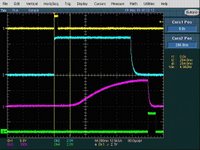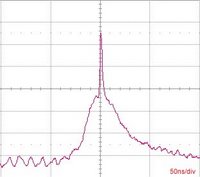Laboratory technical staff members Keith Boyer and Senior Laboratory Fellow Stirling Colgate, are recipients of the 2006 Los Alamos Medal. The Los Alamos Medal is the highest honor and most prestigious award the Laboratory can bestow upon an individual or small group. Director Bob Kuckuck will present the medals during a formal award ceremony and reception at 4 p.m. May 23, in the J. Robert Oppenheimer Study Center.
Recipients of the Los Alamos Medal are evaluated based on their exceptionally distinguished achievements that have impacted the success of the Laboratory, either through influencing mission accomplishments or enhancing distinction, making a contribution that changed the course of science and establishing a major direction for Los Alamos and/or the nation.

"Keith Boyer's and Stirling Colgate's distinguished careers at Los Alamos span more than four decades. Their contributions to Los Alamos and the nation have been immense and further underscore the vital importance this Laboratory has played in the past and the excellent science we continue to perform in support of the nation. I am honored and humbled to be able to present the 2006 Los Alamos Medal and I want to say to them, 'thank you for your contributions,' " said Director Bob Kuckuck.
Boyer has served the Laboratory for 55 years and is recognized as being the intellectual force behind Los Alamos’s entry into magnetic fusion, nuclear rocketry, laser isotope separation and inertial fusion. Boyer, who received his doctorate in nuclear physics from MIT, is credited with introducing and leading dramatic advances in science and engineering and has been involved in producing the first neutrons from a thermal plasma, co-inventing the electron beam carbon-dioxide laser and advancing x-ray lasers for high resolution microscopy. After retirement, he continued research and is responsible for a breakthrough in the development of an x-ray laser camera that promises to offer a nanoscale measurement technique comparable in importance to the development of the optical microscope. He is also recognized for his foresight in recruiting and nurturing excellent research people within the Laboratory.
“I was surprised and delighted to hear about my being awarded the Los Alamos Medal,” said Boyer. “I am particularly appreciative of the very generous support from my peers. I again feel that I am a member of Los Alamos Laboratory and have begun to think of new developments for the Laboratory.”
Colgate’s association with Los Alamos began when he was a student at the Los Alamos Ranch School until it was closed by the government in the early 1940s. He obtained his doctorate in physics from Cornell University and worked at Lawrence Livermore and New Mexico Institute of Mining and Technology. He joined the Laboratory in 1976 where he worked in the Theoretical (T) Division. He is recognized for leading the nuclear diagnostics of the nation’s largest weapons test conducted by Los Alamos, and for negotiating the cessation of high-altitude and outer space nuclear tests. Colgate also has inspired the inertial fusion and astrophysics programs at Los Alamos and Lawrence Livermore and contributed basic science to fusion ignition and burn, plasma confinement and shock wave physics. His other accomplishments include seminal work in supernovae and gamma ray bursts. Colgate is a recognized leader in recruiting leading weapons physicists and demonstrates by example that basic and applied science must be partners.
“So many people contribute to one’s career and this is especially true of a scientist,” said Colgate. “In serving two national labs and a state institution of learning I feel all those many people who have contributed to and encouraged me so much should feel associated with this honor.”
Colgate and Boyer join past Los Alamos Medal winners, Conrad Longmire, Nobel Laureate Hans Bethe, former Laboratory Director Harold Agnew, and Laboratory Fellows Nerses “Krik” Krikorian, George Cowan, Francis Harlow and Louis Rosen in this distinction.
(By Sallie Boorman)

 Randy suggested firing the X-ray Cathode and Anode slightly earlier. The previous delay time was set D=B-1.31us, in this condition the Rail Gap Anode firing was missed sometimes. When the firing time was moved forward, the Rail Gap firing became stable.
Randy suggested firing the X-ray Cathode and Anode slightly earlier. The previous delay time was set D=B-1.31us, in this condition the Rail Gap Anode firing was missed sometimes. When the firing time was moved forward, the Rail Gap firing became stable. Because the output energy of the Prometheus was too low, I decided to passivate it. The chamber was vacuumed this morning, then Helium gas was filled into the chamber about 1 bar. A 16kV H.V. pulse was applied to the rail gap. After filling several mbar fluorine gas, the emission light was changed from white to red. In order to make the railgap firing at the peak time of transformer secondary, I changed the SRS DG-535 channel B timing, from B=A-1.58us to B=A-2.20us. This status has been kept for one hour, then I found a spark on the top 10k Ohm charging resistor. I had to stop passivation, and found the resistor broken. What caused this happened?
Because the output energy of the Prometheus was too low, I decided to passivate it. The chamber was vacuumed this morning, then Helium gas was filled into the chamber about 1 bar. A 16kV H.V. pulse was applied to the rail gap. After filling several mbar fluorine gas, the emission light was changed from white to red. In order to make the railgap firing at the peak time of transformer secondary, I changed the SRS DG-535 channel B timing, from B=A-1.58us to B=A-2.20us. This status has been kept for one hour, then I found a spark on the top 10k Ohm charging resistor. I had to stop passivation, and found the resistor broken. What caused this happened?

 Usually we sent the SYNC OUT signal from SDG II to trigger the Prometheus, it would induce about several hundreds nanoseconds delay time. Today I changed this signal from SYNC OUT to TRIG OUT. Finally I could match the seed beam with the Prometheus ASE.
Usually we sent the SYNC OUT signal from SDG II to trigger the Prometheus, it would induce about several hundreds nanoseconds delay time. Today I changed this signal from SYNC OUT to TRIG OUT. Finally I could match the seed beam with the Prometheus ASE.

